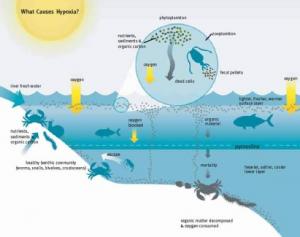|
|
|
What is the Dead Zone?
|

|
The Gulf of Mexico Dead Zone is a large region of water that is very low in oxygen, a condition known as "hypoxia" and therefore can't support life. Dead Zones like this occur along many of the world's coastlines.
Over the past decade, the Dead Zone has grown to an area over 7,000 sq miles, an area larger than the state of Pennsylvania, or the surface area of all the lakes of Minnesota combined. Above the water, the Gulf of Mexico Dead Zone doesn't look any different from the surrounding waters. But along the bottom, there's practically no oxygen -- so fish don't swim in it, and bottom dwelling creatures die off.
| |
|
|
|
|
|
|
Too many nutrients entering the Gulf of Mexico from the Mississippi River are causing the Dead Zone. These nutrients such as animal and human waste, chemical fertilizers from farms, fields, and lawns, and the amount of rain over the Mississippi River basin affect the severity and size of the dead zone as these nutrients flow into rivers that eventually empty into the Gulf of Mexico.
|
|
|
|
The Dead Zone in the Gulf of Mexico and the many other dead zones in coastal waters around the world are damaging the ability of the world's oceans to produce the seafood that you and everyone else desire.Also, the same nutrients that are creating the Dead Zone in the Gulf of Mexico are causing excessive plant and algae growth in tens of thousands of freshwater lakes through the U.S. The result is stinky, algae-choked waters, and even fish kills. Think about that next time you want to go swimming or fishing!
Bottom-dwellers such as snails, worms, starfish, and crabs can't escape the dead zone's oxygen poor water - so they die. Fish and shrimp swim out of the area, or die off, which causes shrimp supply to drop and seafood prices to rise. Over 30% of all the seafood consumed in America comes from the Gulf of Mexico, so we must all do our part to protect this valuable natural resource.
|
|
|
|
Dead zones are not irreversible. The Black Sea dead zone, previously the largest dead zone in the world, largely disappeared between 1991 and 2001 after fertilizers became too costly to use following the collapse of the Soviet Union and the demise of centrally planned economies in Eastern and Central Europe. Fishing has again become a major economic activity in the region.
While the Black Sea "cleanup" was largely unintentional and involved a drop in hard-to-control fertilizer usage, the U.N. has advocated other cleanups by reducing large industrial emissions. From 1985-2000, the North Sea dead zone had nitrogen reduced by 37% when policy efforts by countries on the Rhine River reduced sewage and industrial emissions of nitrogen into the water.
|
|
|
|
|
|
|
- Voluntarily stop fertilizer and waste runoff into lakes, rivers, and streams.
- Enact laws to prevent fertilizer and waste runoff from entering the Mississippi River basin.
- Build water treatment plants to prevent human and animal waste from entering our waters.
|
|
|
|
|
|
|